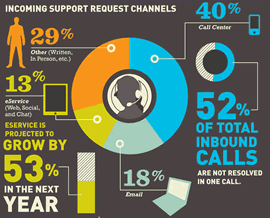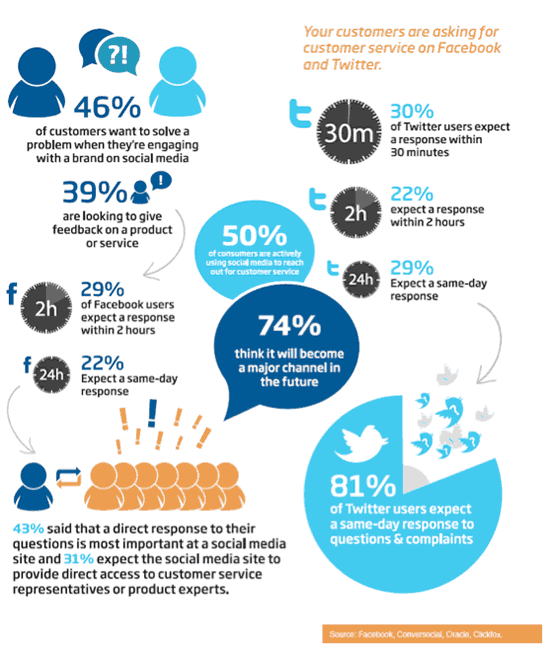 Social customer service or enabling customers to interact with your customer service department or contact center via social today is a must for most businesses. However, it’s not an isolated holy grail. You offer it for a reason and not because everyone tells you that it matters. De facto, that means you enable customers to seek service via social touchpoints in an integrated customer service approach whereby connecting service, customer experiences and the contact center is key .
Social customer service or enabling customers to interact with your customer service department or contact center via social today is a must for most businesses. However, it’s not an isolated holy grail. You offer it for a reason and not because everyone tells you that it matters. De facto, that means you enable customers to seek service via social touchpoints in an integrated customer service approach whereby connecting service, customer experiences and the contact center is key .
Popular platforms like Facebook and Twitter have traditionally been used to air grievances about a company. Those who could not get proper customer service from a business found that social media provided a way for them to overcome their frustration and get what your business owed them.
These complaints not only helped them feel better, but other people who had also been mistreated by the company, loved hearing “someone speak up.” Before too long many other people began to join them and voice their grievances.
This new use of social media as a way to vent consumer indignation even created a new profession–reputation management and digital crisis management. Companies alarmed at their dwindling market share, declining customer base, and falling profit margin would hire marketing firms for purposes of damage control. At least, this culture of fear in the social customer service area exists but it is sometimes, well, a bit over the top. Prioritization and processes matter more than panic.
Beyond reputation: social customer service and social CRM
Social customer service, social CRM and social media in general start with listening, using the proper processes and tools, and defining – ideally proactive – response processes. However, we must get past that defensive attitude and just worrying about reputation and damage control. People expect good customer service and they use social media to seek it so you should offer it.
This doesn’t mean customer service should only be treated on social media, on the contrary. A single customer interaction history view is not only crucial for your customer service effectiveness, it’s also essential to meet the increasing expectations of today’s customers.
Sure, you need to prioritize and answer the social customer service question where it fits best. Nevertheless, in virtually all cases you at least need to listen and have a response process ready. The negative connotations regarding social customer service (bad reputation, criticism, trolls, etc.) should not be an excuse to not provide it. On the contrary: on the social Web it has a potentially higher impact if you don’t respond.
Social customer service is more than ever integrated with marketing, CRM and other business functions. Some even call customer service the new marketing and one wonders indeed if the ROI of customer service can be higher than that of marketing.
Customer service is not about ‘ negativity’. On the contrary: it’s more about pro-actively turning existing customer into loyal customers. It’s an opportunity.
Some people confuse social customer service with social CRM. However, social CRM is not just about customer service. CRM in general has moved beyond the simple customer service processes in this social era.
Customer experiences define the perception your brand. And word-of-mouth thrives on good customer service, a key message in Joseph Jaffe’s Customer Service Manifesto. The link between social customer service, CRM and marketing is obvious. And there is a business case: profit. Within a few years, social media will be channels that are used to seek customer service in the same ways other channels are used. They will become common place. On top of the usual suspects such as Twitter, businesses will use specific social technologies and community platforms for social customer service.
If you ignore the call for social customer service, the price will be negative word-of-mouth; poor brand perception but most of all a higher customer churn rate. According to Gartner, not responding via social channels can lead up to a 15% increase in churn rate. That’s huge, especially if you consider the impact on the bottom-line of existing and satisfied/dissatisfied customers. Obviously this percentage is not universally valid. Again, it depends.
Social customer service expectations
Instead of focusing on damage control, progressive social media savvy companies are beginning to focus on increasing their quality of service in a visible way. In addition to this proactive customer support, positive reviews about experiences with the company have further improved respect for the company and earned approval for its business ethics and practices. Customer service is simply essential and if people want it on social media you can protests against it but that won’t change a thing. However, again: make sure you prioritize and have a response process. Analyze the request and handle it when and where needed. Go in with a plan and make it a properly calculated one whereby customer expectations meet business reality, transparancy, clarity and consistency.
Successful companies, those who have mastered this new way of communicating with their customer base offering social customer service, offer three main suggestions on how to do it well as mentioned in a blog post by Michael Brito (actually a guest post by Rachel Tran, based on Conversocial’s Definitive Guide to Social Customer Service).

The three social customer service elements as Rachel Tran outlines them:
- Be timely. The customer service team has to act fast when complaints show up on social media platforms. This does two things: one, it stops the fire from spreading; and two, it impresses people with how well the company treats its customers. Attention: this doesn’t equal real-time which is an ideal, not an excuse for panic reactions.
- Be helpful. Customer service has to actually provide redress, rather than verbal appeasement. If, for example, someone ordered a product after prepaying for it but never received it, the customer service rep not only has to promise delivery, but also has to contact the shipping department to find out why the customer did not receive their products. In other words, the customer service team should be empowered to follow up on promises made to customers online. And that involves everyone.
- Be cordial. Although someone who is upset may rant and rave about how they have been ripped off by the company, the customer service representative has to take on a completely different tone, responding in a cordial friendly and helpful way to redress the customer issue. That’s how we have been doing in good old sales as well: listen, solve, be happy.
Encouraging social customer service
A company that actually encourages people to contact them through social media about service issue problems will inspire trust, one of the cornerstones of social business and certainly one of the cornerstones of collaboration, which is often the key component of social business as it is embraced today. Trust is about doing what you need to do and promise to do and most of all doing it.
There are two primary benefits to a proactive social customer service approach:
- It becomes convenient for consumers to quickly take care of an issue because they know exactly where to go to get help. Moreover, the growing proliferation of mobile devices allows for consumers to contact the company when and where they prefer.
- The company is transparent. People do understand that businesses have problems: products are not manufactured according to specifications, service delays occur due to unexpected events, and sometimes products are not properly priced or shipped according to schedule. By becoming transparent, a company not only wins sympathy for its side of business problems but also wins approval for conscientiously working to fix things.
Social customer service is not an option anymore. It’s a must and the degree in which it is depends. By integrating it in a broader social business, (social) CRM and overall customer service context with the customer at the centre, it gets the place it deserves. Don’t forget to integrate with other customer service channels, customer data systems and marketing processes and make sure that you don’t ignore the channels people use most to seek service. Social customer service is not an island.
One of the key benefits of social customer service revolves around the possibilities to turn social customer service requests – and social data- in actionable insights that can improve many business areas. However, for many business, it’s still hard to turn the increasing volumes of – unstructured – social data into intelligence, just as it proves hard to connect customer-facing functions and get social (and information) out of the silos in which they often reside. That’s for a next post.


